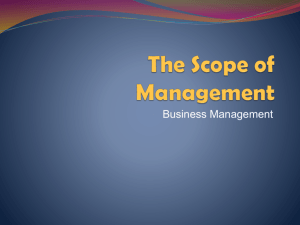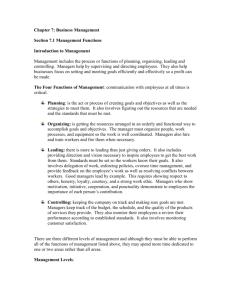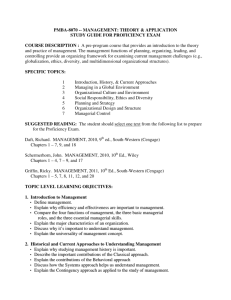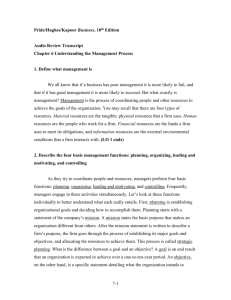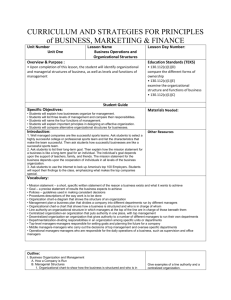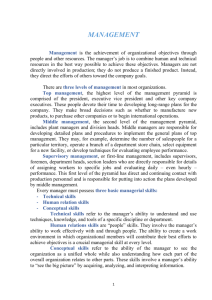Organizational Structures
advertisement
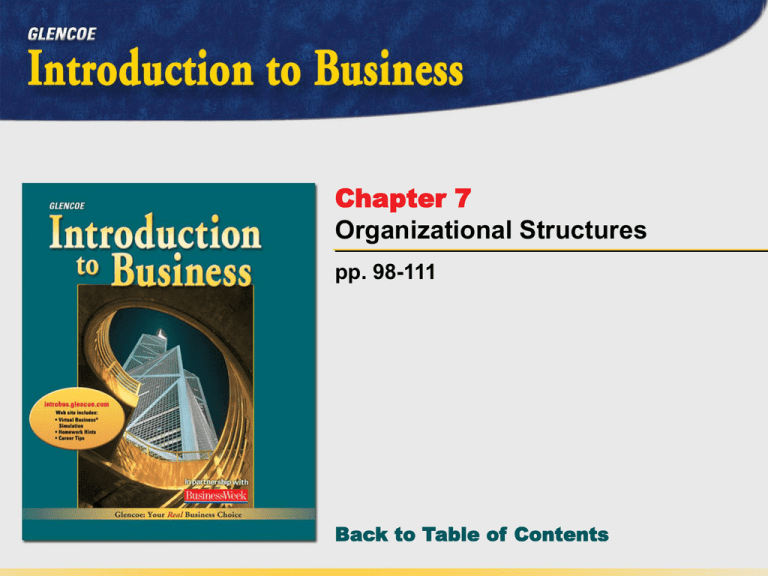
Chapter 7 Organizational Structures pp. 98-111 Back to Table of Contents Chapter 7 Learning Objectives After completing this chapter, you’ll be able to: 1. Explain how businesses organize for management. 2. List three levels of management and compare their responsibilities. continued Introduction to Business, Organizational Structures Slide 2 of 45 Chapter 7 Learning Objectives After completing this chapter, you’ll be able to: 3. Name the four functions of management. 4. Analyze if a managerial position is for you. Introduction to Business, Organizational Structures Slide 3 of 45 Chapter 7 Why It’s Important Understanding business organization and management is key to knowing how a company is run. Introduction to Business, Organizational Structures Slide 4 of 45 Chapter 7 Key Words management plan organizational chart line authority centralized organization decentralized organization departmentalization continued Introduction to Business, Organizational Structures Slide 5 of 45 Chapter 7 Key Words top-level managers middle managers operational managers Introduction to Business, Organizational Structures Slide 6 of 45 Chapter 7 Managerial Structures A management plan divides a company into different departments run by different managers. Introduction to Business, Organizational Structures Slide 7 of 45 Chapter 7 Managerial Structures Companies use an organizational chart to show how the business is structured and who is in charge of whom. Introduction to Business, Organizational Structures Slide 8 of 45 Chapter 7 Managerial Structures One way to organize management is called line authority. Managers at the top of the organization are in charge of those beneath them. Introduction to Business, Organizational Structures Slide 9 of 45 Chapter 7 Managerial Structures Centralized organization puts authority in one place, with top management. Introduction to Business, Organizational Structures Slide 10 of 45 Chapter 7 Managerial Structures Decentralized organization gives authority to a number of different managers to run their own departments. Introduction to Business, Organizational Structures Slide 11 of 45 Chapter 7 Formal Structure Formal structures are usually departmentalized. Departmentalization divides responsibility among specific units, or departments. Introduction to Business, Organizational Structures Slide 12 of 45 Chapter 7 Informal Structure Smaller businesses can be run more informally. If a business does not need a big marketing or distribution network, it does not need a lot of managers. Introduction to Business, Organizational Structures Slide 13 of 45 Chapter 7 Fast Review 1. Match term with definition (handout) Introduction to Business, Organizational Structures Slide 14 of 45 Chapter 7 Levels of Management Most businesses have three levels of managers: • Top-level managers • Middle managers • Operational managers Introduction to Business, Organizational Structures Slide 15 of 45 Chapter 7 Levels of Management Top-level managers are responsible for setting goals and planning for the future. Introduction to Business, Organizational Structures Slide 16 of 45 Chapter 7 Levels of Management Middle managers carry out the decisions of top management. Introduction to Business, Organizational Structures Slide 17 of 45 Chapter 7 Levels of Management Operational managers are responsible for the daily operations of the business. Introduction to Business, Organizational Structures Slide 18 of 45 7 Graphic Organizer Chapter Graphic Organizer Levels of Management TOP LEVEL MANAGERS • Set goals • Plan for the future MIDDLE MANAGERS OPERATIONAL MANAGERS • Carry out the decisions of top management • Plan and control operations • Oversee daily operations • Supervise workers to meet deadlines Introduction to Business, Organizational Structures Slide 19 of 45 Chapter 7 Fast Review 1. Match term with definition 2. Chart Introduction to Business, Organizational Structures Slide 20 of 45 Chapter 7 Planning A good manager has four different functions: • Planning • Organizing • Leading • Controlling Introduction to Business, Organizational Structures Slide 21 of 45 Chapter 7 Planning Long-range planning involves top-level management deciding how the company should perform. Introduction to Business, Organizational Structures Slide 22 of 45 Chapter 7 Planning As part of the planning process, management must answer the following key questions: • What must be done? • Who will do it? continued Introduction to Business, Organizational Structures Slide 23 of 45 Chapter 7 Planning • How will the work be grouped? • Who supervises whom? • Who makes decisions about the work to be done? Introduction to Business, Organizational Structures Slide 24 of 45 Chapter 7 Planning The key questions of the planning process are applied and answered when you get together with your management team. Introduction to Business, Organizational Structures Slide 25 of 45 Chapter 7 Organizing To organize a business plan you need to assign managers different tasks and coordinate their activities. Introduction to Business, Organizational Structures Slide 26 of 45 Chapter 7 Organizing Each manager needs to organize his or her department and know what the other managers are doing. You need to determine who makes decisions and who answers to whom. Introduction to Business, Organizational Structures Slide 27 of 45 Chapter 7 Leading Good management also requires good leadership. You have to create a vision of your company to inspire your employees. Introduction to Business, Organizational Structures Slide 28 of 45 Chapter 7 Leading You need to set standards so your managers know their goals. You need to communicate with them to provide guidance and resolve conflicts. Introduction to Business, Organizational Structures Slide 29 of 45 Chapter 7 Leading You especially want to encourage your employees. Most companies offer incentives such as pay raises and promotions. Introduction to Business, Organizational Structures Slide 30 of 45 Chapter 7 Controlling Controlling means keeping the company on track and making sure all goals are met. Introduction to Business, Organizational Structures Slide 31 of 45 Chapter 7 Controlling You have to keep track of the budget, the schedule, and the quality of the product. You also have to monitor your employees and review their performance. Introduction to Business, Organizational Structures Slide 32 of 45 Chapter 7 Controlling Controlling also involves monitoring customer satisfaction. Introduction to Business, Organizational Structures Slide 33 of 45 Chapter Figure 7.2 7 MANAGEMENT FUNCTIONS Managers carry out four different functions. Which function involves coordinating resources? Introduction to Business, Organizational Structures Slide 34 of 45 Chapter 7 Fast Review 1. What are the four functions of management? 2. What is a manager’s objective in leading? Introduction to Business, Organizational Structures Slide 35 of 45 Chapter 7 Is Being a Manager for You? Most managers begin their careers as company employees. They’re promoted after they have gained experience and have shown certain leadership qualities. Introduction to Business, Organizational Structures Slide 36 of 45 Chapter 7 Is Being a Manager for You? Managerial qualities include: • • • • • Ability to perform varied activities Ability to work under pressure Effective communication Interpersonal skills Ability to gather and use information Introduction to Business, Organizational Structures Slide 37 of 45 Chapter 7 Advantages to Being a Manager Managers usually earn more money than employees in non-management jobs. Being a manager has prestige. Introduction to Business, Organizational Structures Slide 38 of 45 Chapter 7 Advantages to Being a Manager Because managers are leaders, they have more influence than other employees on how the company is run. Introduction to Business, Organizational Structures Slide 39 of 45 Chapter 7 Advantages to Being a Manager Managers also have greater control over their time and how they will spend it. Introduction to Business, Organizational Structures Slide 40 of 45 Chapter 7 Disadvantages to Being a Manager Managers get the blame when things go wrong, even if another employee caused the problem. Introduction to Business, Organizational Structures Slide 41 of 45 Chapter 7 Disadvantages to Being a Manager When managers make mistakes, they can be more costly than other employees’ mistakes because their decisions affect many workers. Introduction to Business, Organizational Structures Slide 42 of 45 Chapter 7 Disadvantages to Being a Manager Some managers feel their relationship with lower-level employees is different than their relationship with fellow managers. Introduction to Business, Organizational Structures Slide 43 of 45 Chapter 7 Fast Review 1. What are five qualities or skills a manager should have? 2. What are the advantages and disadvantages of being a manager? Introduction to Business, Organizational Structures Slide 44 of 45 End of Chapter 7 Organizational Structures pp. 98-111 Back to Table of Contents
